Between 2017 and 2024, key legislative and institutional measures were adopted, including 8 laws and over 90 presidential and cabinet resolutions, laying the regulatory foundation for a deep transformation of the sector.
Electricity production in the country increased by 38%, rising from 59 billion kWh in 2016 to 81.5 billion kWh in 2024. At the same time, per capita generation rose by 18%, reaching 2,200 kWh. Over the past seven years, Uzbekistan commissioned 11,000 MW of new generation capacity – three times the volume added in the preceding 25 years.
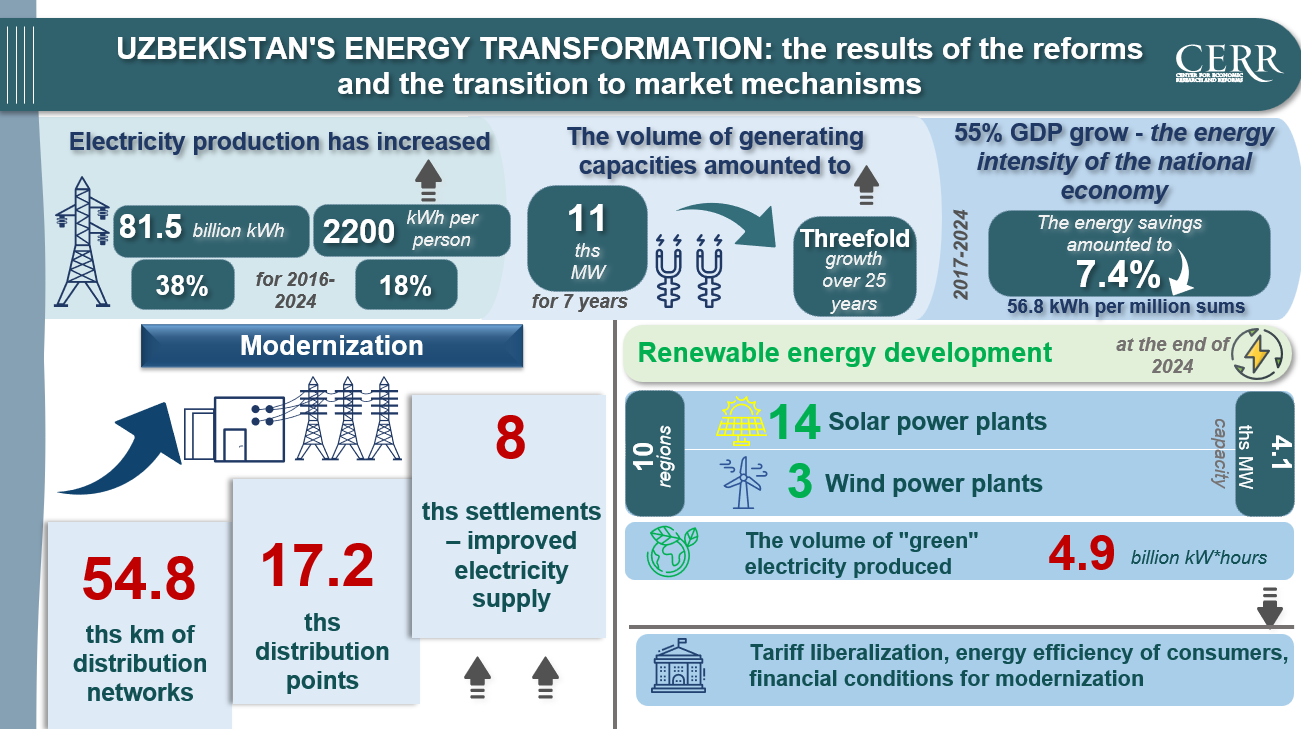
Despite rapid economic growth, Uzbekistan has managed to reduce energy use per unit of economic output. Between 2017 and 2024, the country’s GDP grew by 55%, while energy intensity declined by 7.4%. The economy began operating more efficiently, with industry, services, and agriculture adopting more rational approaches to resource use.
This trend signifies that the economy is producing more value with less energy, with current consumption levels at 56.8 kWh per 1 million sums of added value.
In parallel, over 54,800 kilometers of distribution networks and 17,200 transformer substations were modernized, improving electricity supply in over 8,000 settlements across the country. For comparison, only 9,300 km of power lines and 4,800 transformers were upgraded between 1991 and 2016.
Special attention has been given to the development of renewable energy. By the end of 2024, 14 solar and 3 wind power plants with a total installed capacity of 4,100 MW were commissioned in 10 regions of Uzbekistan. That year, green electricity generation reached 4.9 billion kWh.
Improving the efficiency and rational use of energy resources through tariff liberalization
An important continuation of energy reforms was tariff liberalization, aimed at establishing sustainable market mechanisms and attracting investment to meet rising demand. To assess the impact of this reform, the Center for Economic Research and Reforms (CERR) conducted a study analyzing household behavior under the new tariff policy, which introduced a social consumption norm in May 2024.
The survey covered 3,516 households nationwide. In addition, consumption data from 3.5 million gas and 8 million electricity subscribers were analyzed, offering insights into energy usage changes and public response to the new pricing policy.
Findings showed that from May to December 2024, electricity consumption decreased by 10.6% compared to the same period in 2023 – equivalent to savings of 1.3 billion kWh.
Notably, the number of households consuming over 10,000 kWh per month dropped sharply from nearly 80,000 in 2023 to just 15,000 in 2024.
Interestingly, the majority of citizens continued using energy within familiar limits. The share of subscribers consuming up to 200 kWh per month remained stable – 71% in 2023 and 72% in 2024.
Similar trends were observed in natural gas consumption: in 2024, 58% of subscribers used up to 500 cubic meters, compared to 54% in 2023. The tariff increase did not lead to drastic changes in basic consumption volumes.
The most notable reductions occurred in regions with previously high consumption levels, such as Samarkand, Tashkent, Andijan, and Namangan, indicating a shift toward more efficient energy use among households.
Simultaneously, the quality of energy supply improved. According to the survey, almost half of respondents reported positive changes in access to electricity, natural gas, and liquefied gas.
47% of households noted improvements in electricity supply, with particularly high satisfaction in Surkhandarya (78%), Syrdarya (70%), and Namangan (67%) regions.
39% observed better access to natural gas, with the highest levels recorded in Khorezm and Surkhandarya (both 68%), and Jizzakh (60%).
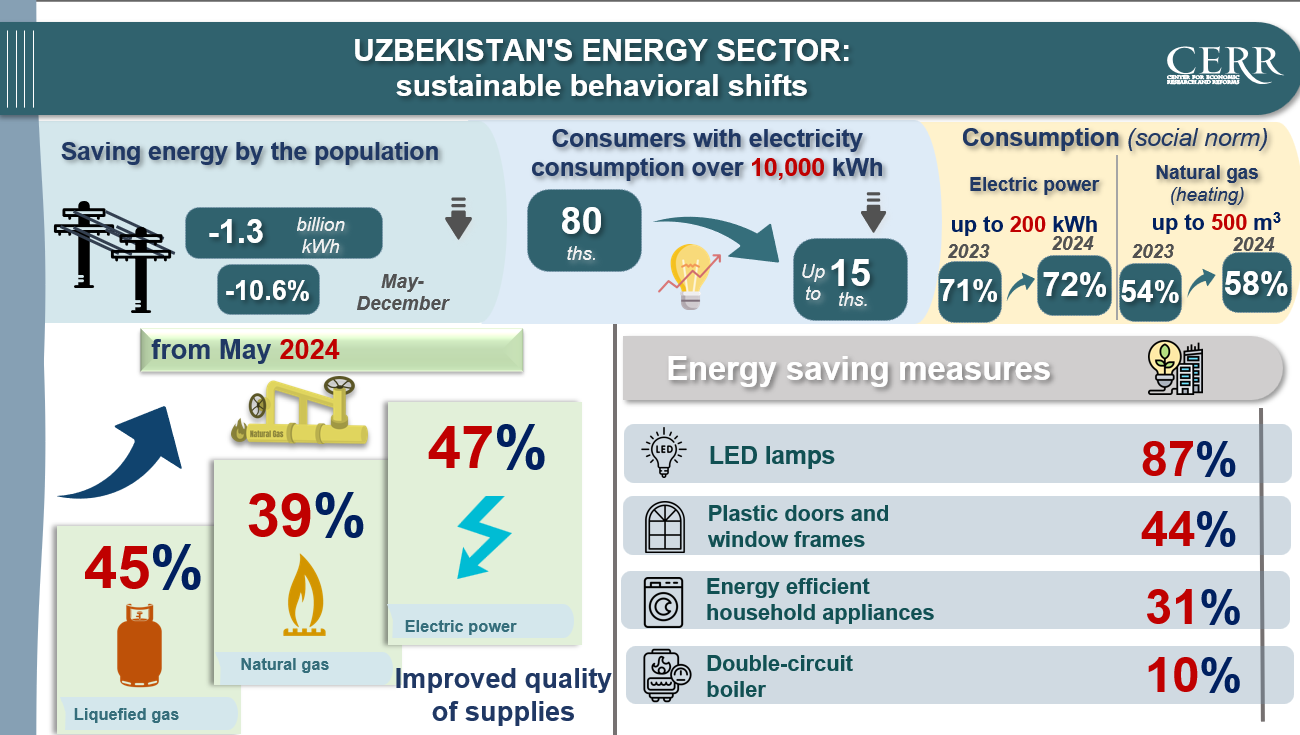
45% reported improved liquefied gas supply, particularly in Syrdarya (73%), Surkhandarya (62%), and Namangan (59%). These results indicate broader access to basic energy services as a result of ongoing reforms.
One of the key developments has been the widespread adoption of energy-efficient solutions at the household level. Over 90% of respondents reported implementing at least one measure to reduce energy costs.
The most common measure was switching to LED lighting – adopted by 87% of households. In some regions (Republic of Karakalpakstan, Khorezm, Navoi, and Tashkent) this figure exceeded 90%.
44% of households improved window and door insulation by installing plastic fittings, especially in Kashkadarya (84%), Bukhara (69%), and Khorezm (54%).
31% purchased energy-efficient appliances, with the highest shares in Jizzakh (60%), Navoi (59%), and the Republic of Karakalpakstan (54%).
In addition, there is growing interest in renewable energy solutions.
Already 64,000 households across the country have installed solar panels with a total capacity of 223.4 MW. Their annual output is approximately 313 million kWh, which is equivalent to savings of 104 million cubic meters of natural gas.
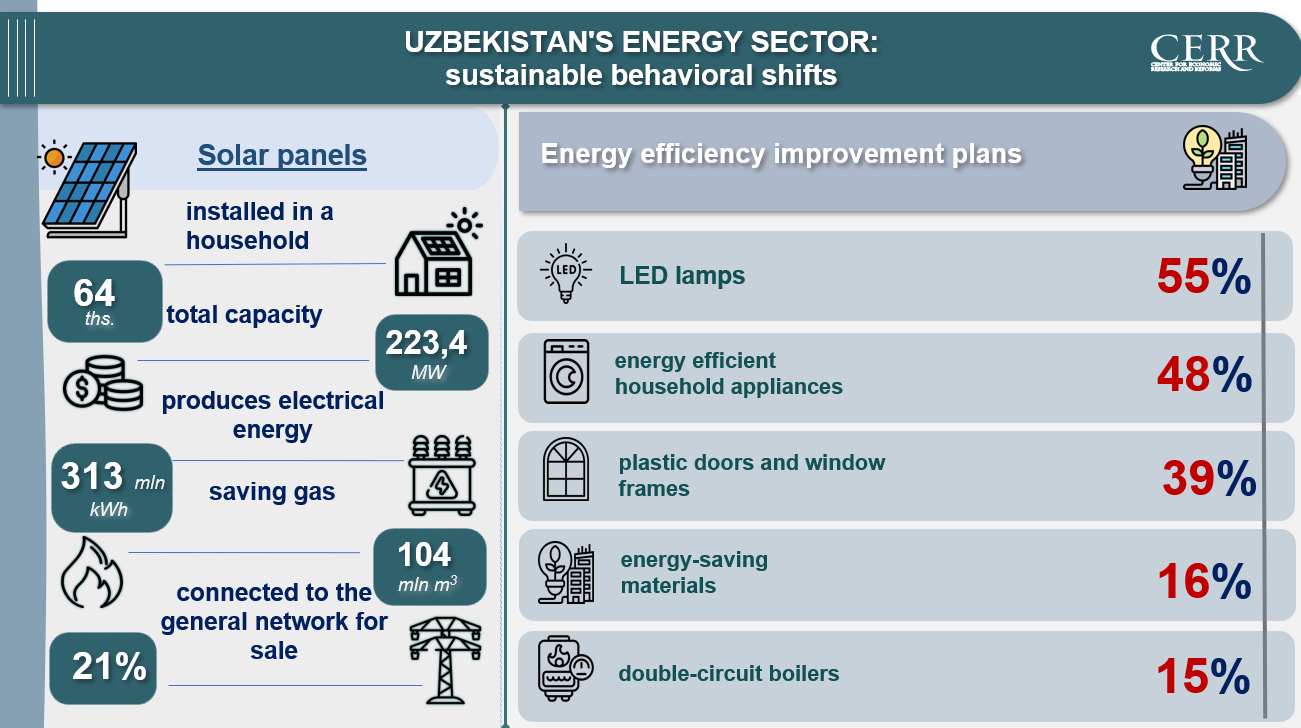
More than half of the households with solar installations expressed satisfaction with the results and interest in expanding their generation capacity. Analysis shows that the potential demand for solar panels among the population stands at around 1.9 million households, opening up prospects for the development of a domestic market worth over $2.3 billion.
At the same time, a significant share of energy consumption still comes from less efficient heating sources, including outdated gas boilers and solid fuel stoves – highlighting the need to modernize residential infrastructure and provide incentives for adopting modern technologies.
In parallel, there is a growing investment potential in improving the energy efficiency of buildings. It is estimated that Uzbekistan’s apartment housing stock could save more than $60 million per year through thermal insulation of facades, modernization of heating systems, and replacement of outdated windows and doors.
Improving energy efficiency: economic benefits and environmental impact
According to World Bank estimates, a similar potential exists in public sector buildings, including schools and healthcare facilities, where targeted investments in thermal modernization could reduce energy consumption by 20% to 50% and create the potential to save up to 7.1 billion kWh of electricity annually.
In addition to economic benefits, these measures would contribute to a significant reduction in greenhouse gas emissions by up to 780,000 tons of CO₂ per year. Uzbekistan already operates a carbon trading market, and has been successfully selling surplus emission quotas to other countries. The implementation of these measures could further increase the volume of such sales, potentially generating up to $50 million in annual revenue.
The ongoing reforms ensure a phased transition toward a sustainable and efficient energy system, based on modernization, energy efficiency, and market-based principles.
CERR Public Relations Sector
Tel: (78) 150 02 02 (417)

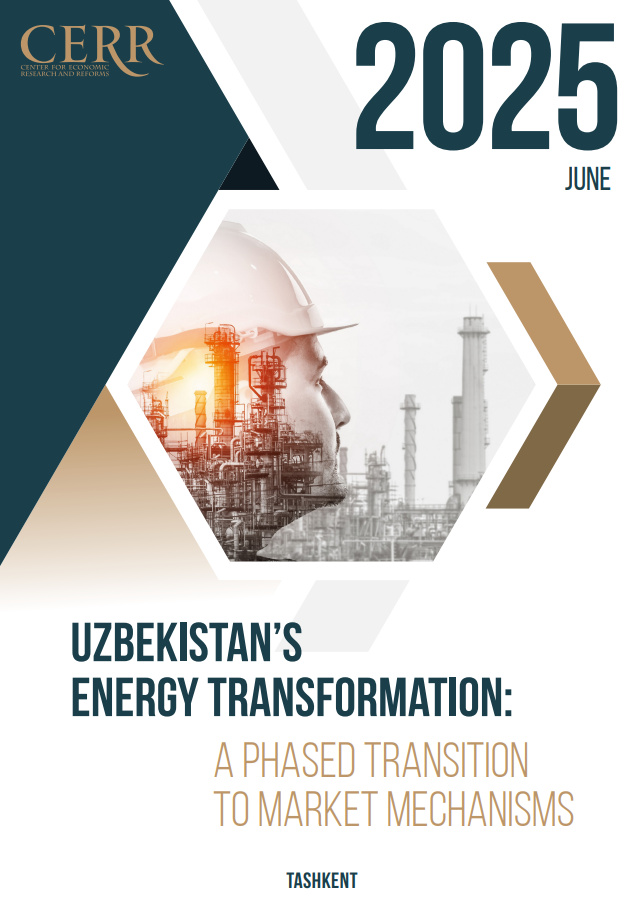
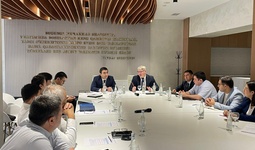

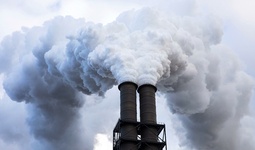
















leave a comment